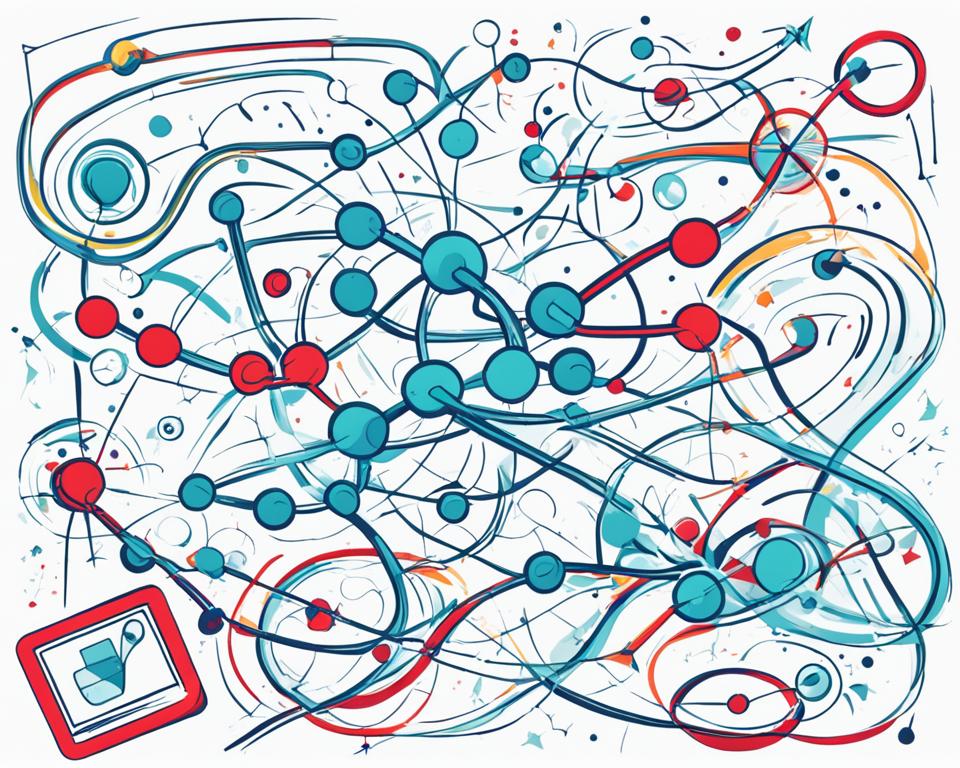In various fields of study and practice, causation serves as a fundamental concept that empowers us to understand the relationship between cause and effect. It pertains to the notion that a particular event or action has the power to lead to a specific outcome. Causation holds immense significance in research, as well as legal scenarios, allowing us to distinguish between causation and correlation.
Unlike correlation, which merely reveals a connection between variables, causation goes a step further by demonstrating a direct cause-and-effect relationship. Establishing causation enables researchers to analyze their findings accurately and aids in the establishment of liability in legal cases.
Key Takeaways:
- Causation refers to the relationship between cause and effect, where one event or action leads to a specific outcome.
- In research, causation helps establish causal relationships between variables, whereas correlation demonstrates a statistical relationship.
- Understanding causation is essential for distinguishing between causation and correlation, as well as for analyzing research findings and establishing liability in legal cases.
- Causation is a vital concept in various fields, enabling accurate interpretations and informed decision-making.
Types of Causation
Understanding the different types of causation is crucial in analyzing the relationship between cause and effect. Two common types of causation are cause-in-fact causation and proximate causation. Let’s explore each type in detail.
Cause-in-Fact Causation
Cause-in-fact causation, also known as factual causation, focuses on the actual evidence or facts that prove a party’s responsibility for causing harm, damage, or loss. It seeks to answer the question: Would the harm have occurred without the defendant’s actions?
For example, in a car accident case, cause-in-fact causation determines whether the defendant’s distracted driving directly led to the accident. The evidence presented, such as witness testimonials or video footage, would be crucial in establishing cause-in-fact causation.
Proximate Causation
Proximate causation is a more complex legal concept that considers the reasonable foreseeability of harm caused by an action. It goes beyond the direct causal link and takes into account the broader consequences of an action.
An example of proximate causation can be seen in cases involving property owner negligence. If a person trips and injures themselves due to a hazardous condition on someone’s property, proximate causation would assess whether the property owner could have reasonably foreseen the potential harm caused by their negligence.
Examples of Causation
Causation examples can be found in various real-life scenarios, including:
- Car accidents caused by distracted driving
- Injuries resulting from property owner negligence
- Health issues caused by exposure to toxic substances
- Product malfunctions leading to injury or property damage
Understanding these types of causation and their real-world examples is essential in legal, research, and everyday contexts. It allows for a deeper comprehension of the cause-and-effect relationship between actions and their outcomes.
| Type of Causation | Description |
|---|---|
| Cause-in-Fact Causation | Focuses on the actual evidence or facts that prove a party’s responsibility for causing harm. |
| Proximate Causation | Considers the reasonable foreseeability of harm caused by an action. |
Causation in Research
Causation plays a crucial role in research, particularly in establishing causal relationships between variables. While correlation indicates a relationship between variables, it does not prove causation. To establish causation in research, researchers often use experimental designs or controlled studies, where variables are manipulated to determine if changes in one variable cause changes in another.
For example, let’s consider a study examining the effect of exercise on weight loss. Researchers would randomly assign participants to two groups: one group that engages in regular exercise and another that does not. By tracking and comparing changes in weight over time between the two groups, researchers can determine if exercise directly causes weight loss.
However, it’s important for researchers to consider other factors and potential confounders that could influence the results. Factors such as diet, genetics, and lifestyle choices may also contribute to weight loss, so researchers must account for these variables to accurately establish causation.
Here is a table summarizing the differences between correlation and causation in research:
| Correlation | Causation |
|---|---|
| Indicates a relationship between variables | Establishes a direct cause-and-effect relationship |
| Does not prove causation | Provides evidence of causation |
| Can be coincidental or spurious | Requires careful research design and analysis |
| Observational or correlational studies | Experimental or controlled studies |
This table highlights the importance of designing studies that can establish causation rather than relying solely on correlation. By carefully manipulating variables and controlling for confounders, researchers can strengthen the evidence for causation in their research findings.
Causation vs. Correlation
Causation and correlation are often confused but have distinct differences. Correlation refers to a statistical relationship between variables, where changes in one variable tend to be associated with changes in another. However, correlation does not imply causation. In other words, just because two variables are correlated does not mean that one variable causes the other. Causation, on the other hand, denotes a direct cause-and-effect relationship, where changes in one variable directly result in changes in another.
Understanding the distinction between causation and correlation is essential in various fields, including research and legal contexts. While correlation can indicate the existence of a relationship between two variables, it does not provide evidence of a causal link. Establishing causation requires further investigation to determine if there is a direct relationship between the variables under study.
In research, the difference between causation and correlation is crucial. Correlation serves as a starting point for exploring potential causation, but additional analysis is needed to establish a causal relationship. Researchers use experimental designs and controlled studies to manipulate variables and determine whether changes in one variable cause changes in another. By doing so, they can better understand the causative factors at play.
In legal scenarios, the distinction between causation and correlation is equally important. In proving liability or determining fault, it is not enough to establish a correlation between an action and an outcome. The direct causal link between the action and the harm must be demonstrated for legal causation to be established.
Legal Causation
In legal scenarios, causation plays a critical role in determining liability and establishing fault. Specifically, in personal injury cases, legal causation refers to the direct link between a defendant’s negligent action or omission and the resulting harm or injury suffered by the plaintiff.
To establish legal causation, plaintiffs must demonstrate two key elements:
- The harm would not have occurred without the defendant’s actions: It is essential to establish that the defendant’s behavior directly contributed to the occurrence of the harm. This requires presenting evidence that supports a causal connection between the defendant’s actions and the resulting harm. By demonstrating that the harm would not have happened in the absence of the defendant’s actions, plaintiffs strengthen their case for legal causation.
- The harm was a foreseeable consequence of the defendant’s actions: Plaintiffs must also show that the harm suffered was a reasonably foreseeable consequence of the defendant’s actions or omissions. For example, if a driver fails to stop at a red light and causes a collision resulting in injuries, it must be established that the harm of injuries was reasonably foreseeable given the defendant’s disregard for traffic laws.
Legal causation is an essential factor in determining liability and awarding damages in personal injury lawsuits. Without establishing a direct causal link between the defendant’s actions and the resulting harm, it becomes challenging to hold the defendant responsible for the injuries or losses suffered by the plaintiff.
| Role of Legal Causation in Personal Injury Cases | Importance |
|---|---|
| Proving Fault | Legal causation helps establish the defendant’s fault by demonstrating the direct link between their actions and the harm suffered by the plaintiff. |
| Liability Determination | Legal causation is crucial in determining the defendant’s liability for the injuries or losses sustained by the plaintiff. |
| Damage Assessment | By establishing legal causation, the court can accurately assess the damages owed to the plaintiff, considering the direct consequences of the defendant’s actions. |
Understanding the concept of legal causation is vital for both plaintiffs and defendants in personal injury cases. Plaintiffs need to present strong evidence demonstrating the causal link between the defendant’s actions and the harm suffered, while defendants must challenge or disprove such causal relationships to mitigate their liability.
Conclusion
Causation is a fundamental concept that underlies relationships in various fields, including research, philosophy, and legal scenarios. Understanding the difference between causation and correlation is crucial for accurate analysis and decision-making. Whether in the context of scientific studies, determining liability in legal cases, or exploring the philosophical implications of causation, recognizing the distinction between causation and correlation allows for more accurate interpretations and informed decision-making.




